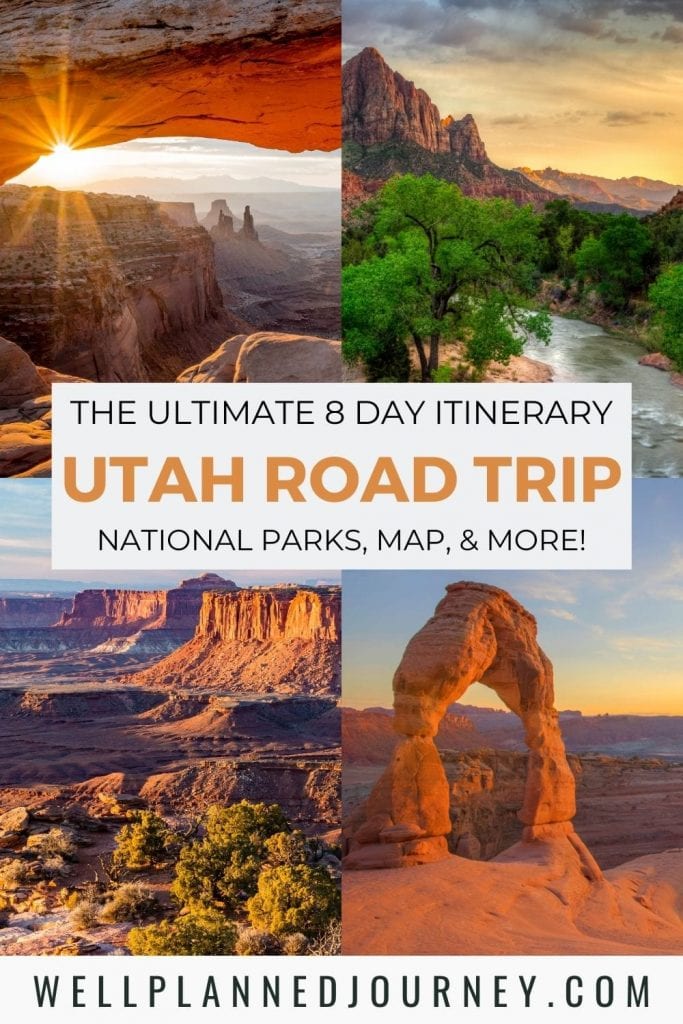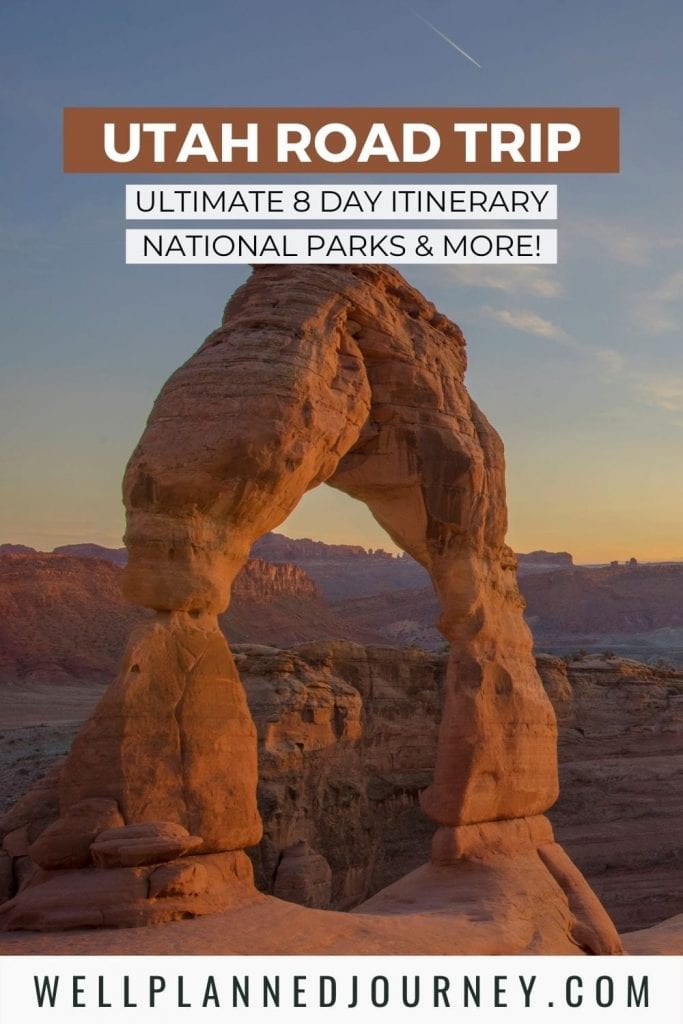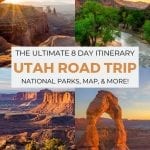This guide to the best Utah national parks covers all the highlights, plus a few side trips along the way! By the end of this post, you’ll have the perfect plan to make the most of your trip to Utah’s five national parks.
Important Note
In 2024, Arches National Park will require all visitors to get a timed entry permit to enter the park from April to October. You can read more about how to get your Arches entry reservation here. The other four Utah national parks are not requiring a reservation to enter the park.
This post may contain affiliate links, where I may receive a small commission at no additional cost to you. Read more in this disclosure policy.
Utah National Parks Road Trip Route
Start your Utah national parks road trip in either Las Vegas or Salt Lake City. This trip can be done from either airport, so pick the one with cheaper flights for you. While flying into Las Vegas adds a bit more driving time, it’s the best option if you plan to add on other destinations in Arizona like Monument Valley, Lake Powell, or the Grand Canyon.
From there, you’ll start your trip with Zion National Park and end with Canyonlands National Park. You’ll visit all of the “Mighty 5” Utah national parks in 8 days on this loop. Here are the approximate driving distances between the parks.
- Las Vegas to Zion: 2.5 hours / 160 miles (3.5 hours / 275 miles from Salt Lake City)
- Zion to Bryce Canyon: 2 hours / 85 miles
- Bryce Canyon to Capitol Reef: 2.5 hours / 120 miles
- Capitol Reef to Arches: 2.5 hours / 145 miles
- Arches to Canyonlands: 35 minutes / 30 miles
- Canyonlands to Las Vegas: 7 hours / 480 miles (4 hours / 250 miles from Salt Lake City)
Utah Mighty 5 Route Map
Check out the map below for the full 8-day Utah national parks road trip route! Choosing to start in Salt Lake City saves a bit of driving, but you may be able to find a cheaper flight and rental car out of Las Vegas.
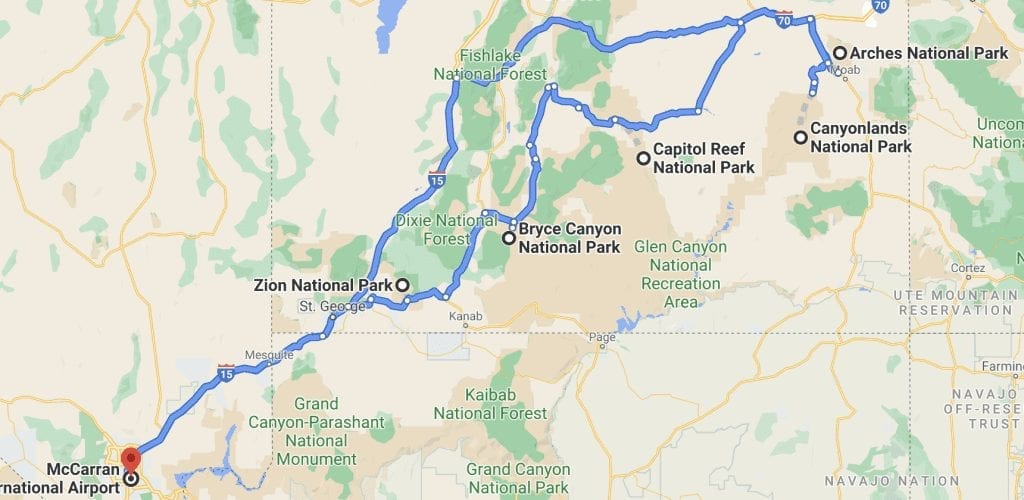
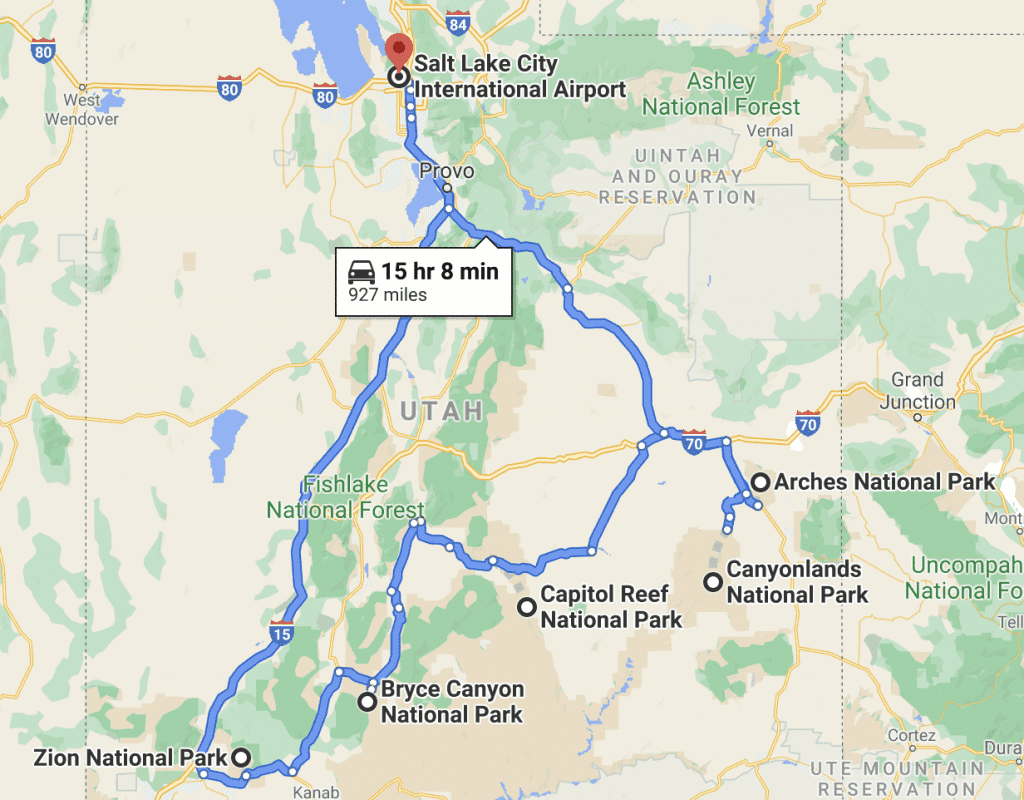
How to Get Around Southern Utah
The first day of this epic Utah national parks road trip starts in Las Vegas or Salt Lake City, depending on where you’re able to find the cheapest flight.
I recommend booking the earliest possible flight, giving you time to relax and explore as you drive to Zion National Park.
You’ll need to rent a car at the airport to get to and from the national parks. I recommend renting an AWD vehicle for this trip. While not absolutely necessary, an all-wheel-drive vehicle will allow you to explore some of the most scenic parts of this itinerary by traversing unpaved roads in Capitol Reef National Park.
Before heading out, download Google Maps offline in the mobile app so you can navigate without cell service. Much of southern Utah is outside of cell signal range, so this is a crucial step.
Best Time to Visit the Utah National Parks
For most visitors, the best time to visit will be late spring or early fall. I recommend planning your trip from mid-early to Memorial Day or Labor Day to early October. That said, all five national parks remain open year-round and are accessible even in the winter months.
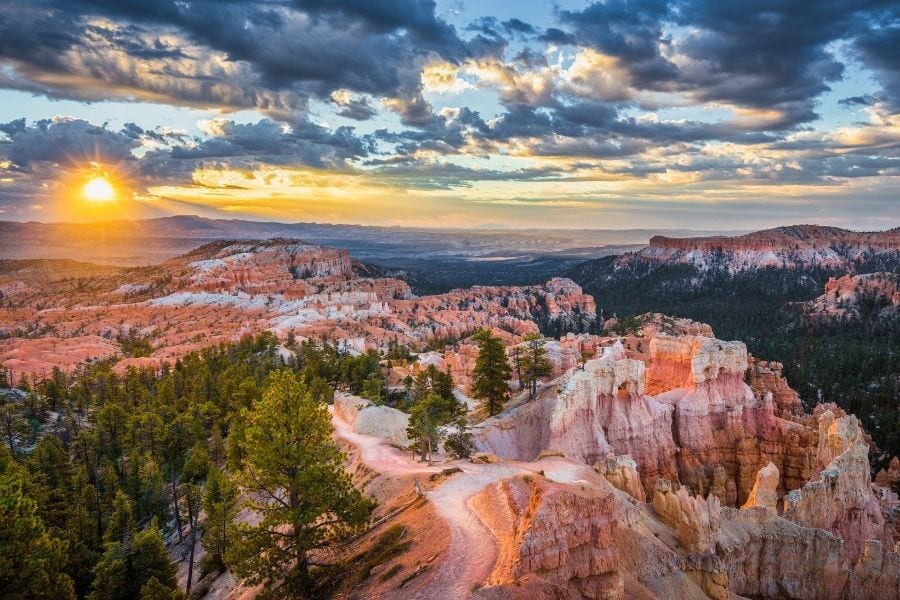
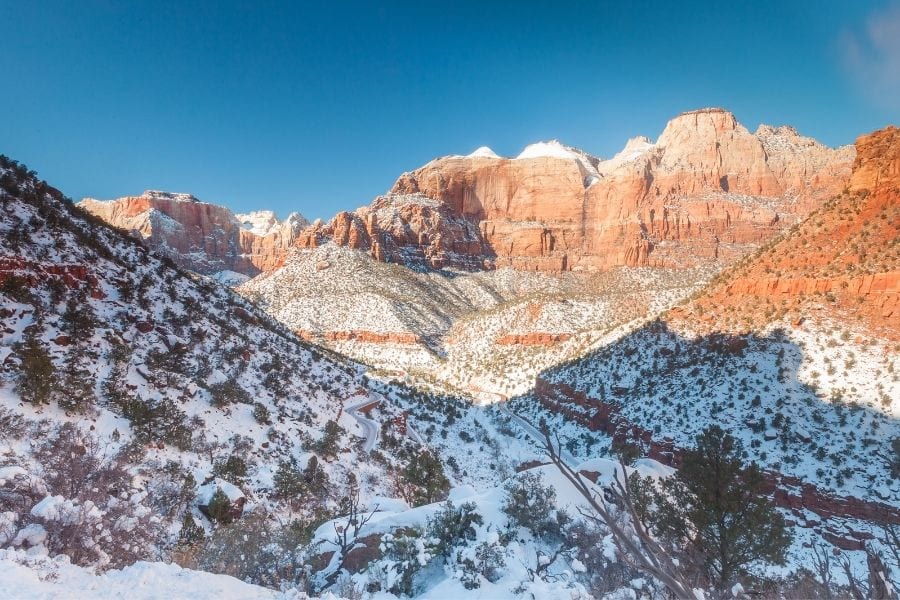
Here’s a quick overview of each season in the Utah parks:
- Spring: Temperatures are warm but not unbearably hot during the day, perfect for hiking. In the Spring, crowds are lower ahead of the peak season. But if you want to hike The Narrows in Zion, water levels are still too high this time of year. This is one of the best seasons to visit Utah’s national parks.
- Summer: By early summer, temperatures are hot, often in the 80s and 90s. This is also the most crowded time of year, particularly in Zion National Park and Arches National Park. While you may have to battle crowds, summer has the perk of all park amenities being open and kids out of school.
- Winter: The winter months in Utah are beautiful, but snow and freezing temperatures limit your ability to hike. The major benefit of visiting Utah in the winter is the minimal crowds.
- Fall: As temperatures decline in the fall, so do the crowds. The weather is great for hiking (including The Narrows in Zion!), making this an excellent time to visit southern Utah.
Utah National Parks Itinerary
This Utah national parks road trip is an 8-day loop. You can complete this loop from either Las Vegas or Salt Lake City airports.
If you have less than 8 days, you can condense this trip by only spending one day in each park. Throughout this itinerary, I’ll provide suggestions on must-do activities if you are short on time.
Here’s a quick overview of each day:
- Day 1: Drive to Zion National Park
- Day 2: Zion National Park
- Day 3: Zion & Drive to Bryce Canyon
- Day 4: Bryce Canyon & Drive to Capitol Reef
- Day 5: Capitol Reef National Park
- Day 6: Drive to Arches National Park
- Day 7: Arches National Park
- Day 8: Canyonlands National Park & Return Home
Have more time to spend in Utah? Check out the section at the end of this article for recommendations on additional stops to add to your trip.
Don’t miss the best of Utah’s national parks on your upcoming trip! This free, printable Utah national park road trip itinerary covers all the best points of interest in all 5 Utah parks, plus bonus tips on where to stay and side trips to nearby state parks and monuments.
Download your free Utah road trip itinerary here.
Days 1 to 3: Zion National Park
Drive Time: 2.5 hours from Las Vegas or 3.5 hours from Salt Lake City
Crowd Levels: 5 out of 5

Zion National Park was the first national park of Utah’s “Mighty 5”, established over 100 years ago. Each year, Zion attracts over 4 million visitors. People flock to Zion for its bucket list-worthy hikes and incredible views.
But even if you aren’t a hiker, Zion National Park has something for you! There are scenic drives, paved walking trails, bicycle paths, and adventure sports, too.
Important Notes About Zion:
Zion National Park is requiring all visitors to get an advance permit to hike Angels Landing. You can read more about how to get an Angels Landing permit here.
The main route to Observation Point is closed due to a rockslide in 2019. However, there’s an alternate route to reach the peak, which you can read about in my Observation Point blog post.
Can’t Miss Activities in Zion National Park
- Hike Angels Landing or Observation Point
- Hike The Narrows
- Hike Canyon Overlook
- See sunset at Canyon Junction Bridge
- Drive Zion-Mt. Carmel Scenic Highway
Day 1
Most of your first day on this trip will be spent getting to Zion National Park. If you arrive in Salt Lake City or Las Vegas on an early flight, you may have some time to explore Zion in the afternoon.
I recommend spending your afternoon or evening getting settled into Zion National Park, your home for the next few days.
Day 2
This is your first full day in Zion National Park. Zion requires all visitors from Spring to Fall to take the shuttle throughout the park. Often in the summer, shuttle lines can reach an hour long.
That’s why it’s incredibly important to get your day started early.
Start your second day in Utah shortly after sunrise. You’ll want plenty of time to hike The Narrows! This famous trail isn’t actually a trail at all – you’ll spend your “hike” wading up the Virgin River between canyon walls.
While the official hike is 9.4 miles, many hikers just wade as far as they want upstream before turning back.

If you’re visiting Zion in the late Spring, you’ll want to rent wading overalls and boots from Zion Outfitter if water levels are low enough to hike this trail. If you’re visiting Zion in the Summer or early Fall, you’ll be okay in shorts and waterproof shoes.
End your day in Zion National Park with sunset at Canyon Junction Bridge. Facing south, your eyes follow the path of the Virgin River out to The Watchman – the park’s famous guardian.
Sunset at Canyon Junction Bridge is popular amongst photographers, so get there early to find your perfect vantage point.
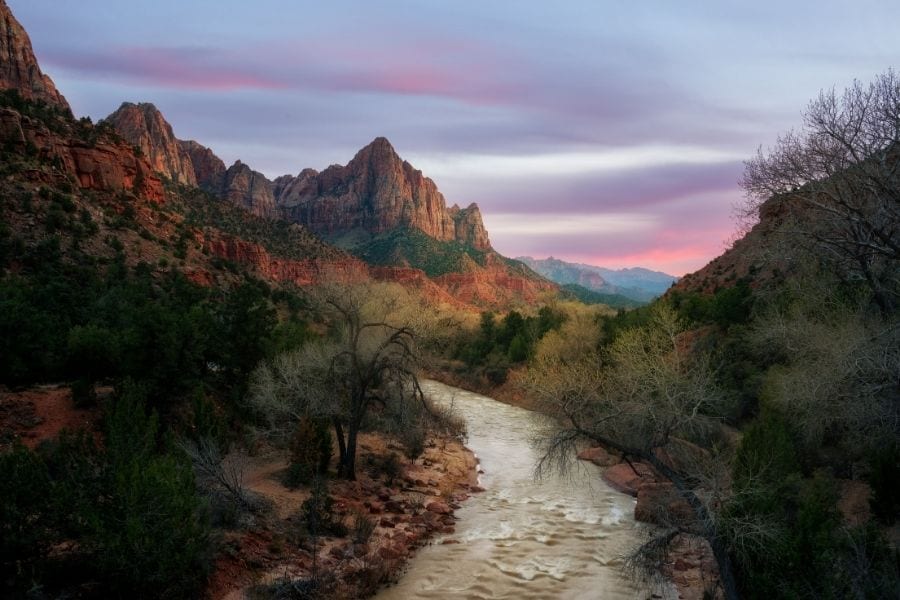
Day 3
After a full day of exploring the canyons carved by the Virgin River, it’s time to see Zion from above on Day 3. Choose between the park’s two best elevation-gaining hikes: Angel’s Landing or Observation Point.
Angel’s Landing is the most popular hike in the park. This trek is not for those with unsure footing or a fear of heights. Hikers navigate sheer 1,200-foot drop-offs holding on to a chain bolted in the rock.
This is the most congested trail in the park, so it’s important to get an early start. I recommend taking the first shuttle into the park at 6 am.
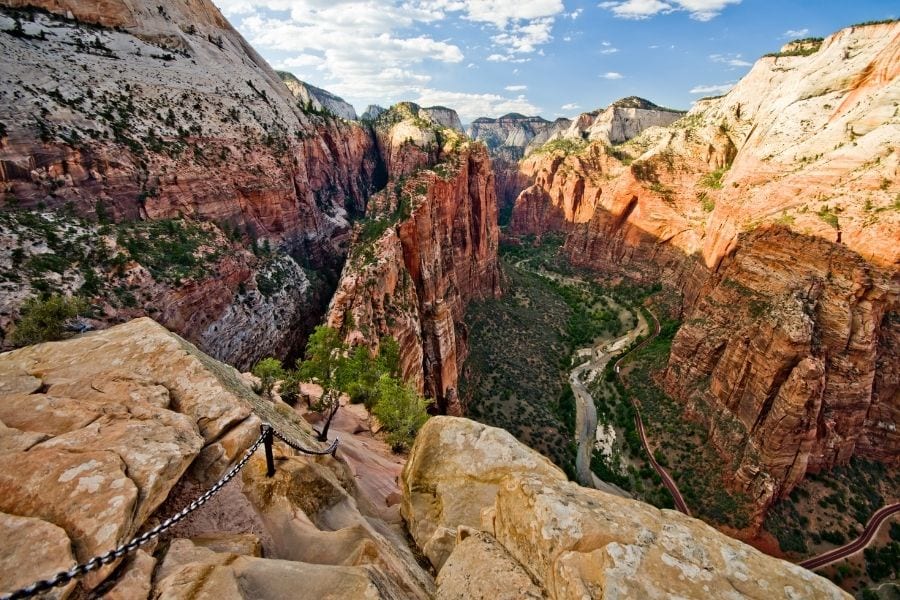
If crowds and dangerous drop-offs aren’t for you, consider hiking Observation Point instead.
The peak of Observation Point stands another 1,000 feet above Angel’s Landing. From this vantage point, you can see the southern part of the park in its entirety.
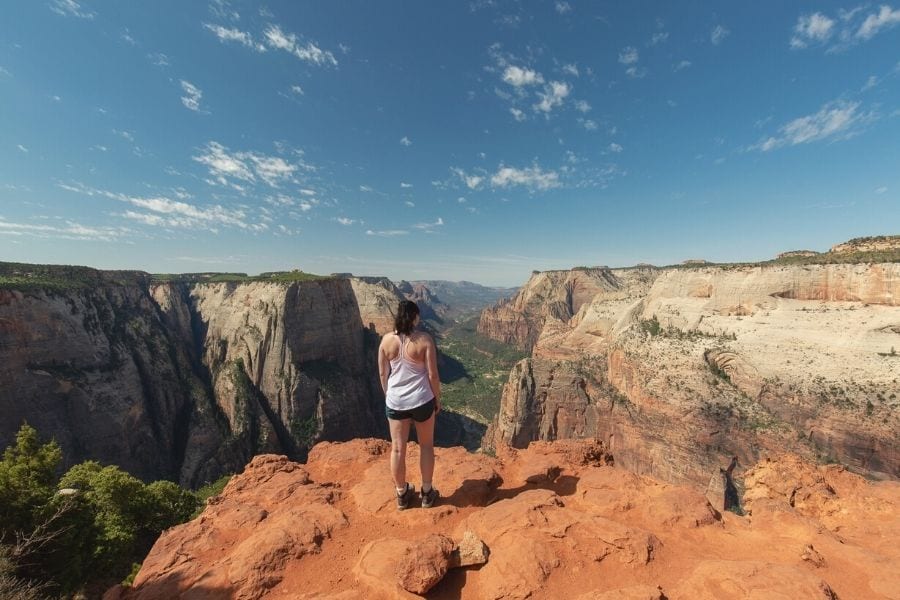
After your hikes in Zion, it’s time to say your final goodbyes to Utah’s most popular national park and head to Bryce Canyon National Park.
On your way out of the park, drive the steep switchbacks up to the Zion-Mount Carmel Tunnel – a historic landmark built in the 1920s. Just after exiting the tunnel, you’ll see the trailhead for the Canyon Overlook trail. This quick 1-mile hike ends at a view of Zion Canyon.

As you continue through the rusty red rocks on the scenic Zion-Mount Carmel Highway, keep your eyes peeled for mountain goats and Checkerboard Mesa. This unique rock formation was formed through erosion from both freezes and wind.
Follow the road out to Highway 89, then up to Highway 12. You’ll gain over 4,000 feet as you drive to Bryce Canyon – the highest elevation park of the Utah “Mighty 5”. The drive from Zion to Bryce Canyon is just under 2 hours.
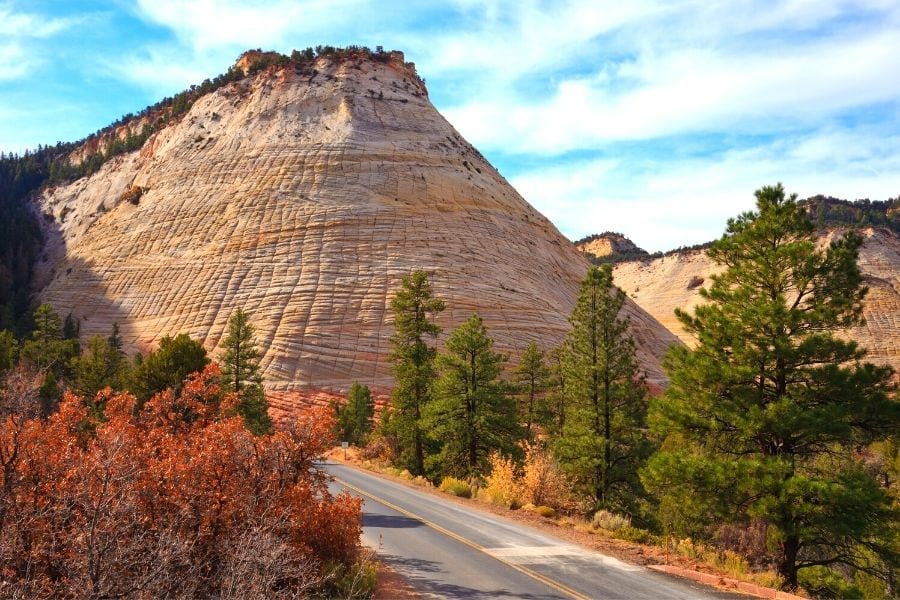
Where to Stay Near Zion National Park
Unlike many national parks, Zion has a decently sized town right next door: Springdale. Here you can find plenty of hotels or home rentals. Plan to book hotels in Springdale at least 3 months out.
Inside the park, you’ll find a handful of campgrounds and a lodge. To stay in the park, book 6 months out for campgrounds and a year out for the lodge.
This interactive map can also help you search all the available hotels and rental properties near Zion National Park! Simply scroll and click the map below to see what is available!
Inside the Park:
- Zion Lodge, the only hotel inside the park
- Watchman Campground, reservable 6 months out
- South Campground, reservable 14 days in advance
Outside the Park:
- Cliffrose Lodge, for a more luxurious stay in Springdale
- Driftwood Lodge, for budget travelers in Springdale
Where to Eat Near Zion National Park
- The Parkhouse Cafe
- Cafe Soleil
- King’s Landing Bistro
- Oscar’s Cafe
- The Spotted Dog Cafe
- Whiptail Cafe
- Deep Creek Coffee Company
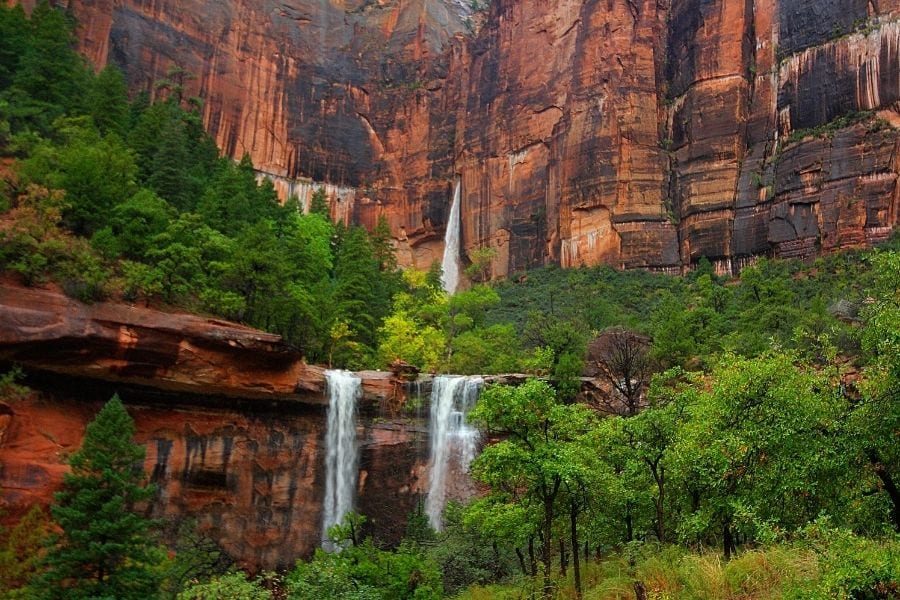
If You Have More Time in Zion
- Hike The Subway, a difficult but incredibly scenic hike that requires a permit
- Hike Emerald Pools, an easy family-friendly waterfall hike
- Explore Kolob Canyons, a separate, less crowded part of the park
Day 4: Bryce Canyon National Park
Drive Time: 2 hours from Zion National Park
Crowd Levels: 4 out of 5

Bryce Canyon National Park has one of the most unique landscapes in the world. It’s famous for its hoodoos, rock formations formed by erosion. These hoodoos can only be found in a few places around the world!
In fact, Bryce Canyon has the largest concentration of hoodoos in the world! That’s why millions of people come to marvel at them every year. Bryce Canyon is also one of the best places in the United States to stargaze and spot the Milky Way!
Can’t Miss Activities in Bryce Canyon
- See sunrise at Sunrise Point
- Hike Queen’s Garden/Navajo Loop
- Drive Bryce Canyon Scenic Drive
Day 4
You’ll only have one quick day in Bryce Canyon National Park, so get an early start to make the most of it! The good news is that it’s easy to see the highlights of Bryce Canyon in only a day.
Sunrise in Bryce Canyon is unlike anything I’ve ever seen before. The park’s famous hoodoos illuminate with the purples, pinks, and oranges of the rising sun.
Arrive at Sunrise Point before dawn to take in the last few minutes of the starry night sky. As the sun creeps over a distant plateau, the hoodoos in Bryce Canyon Amphitheater come alive and reflect the first light of day.
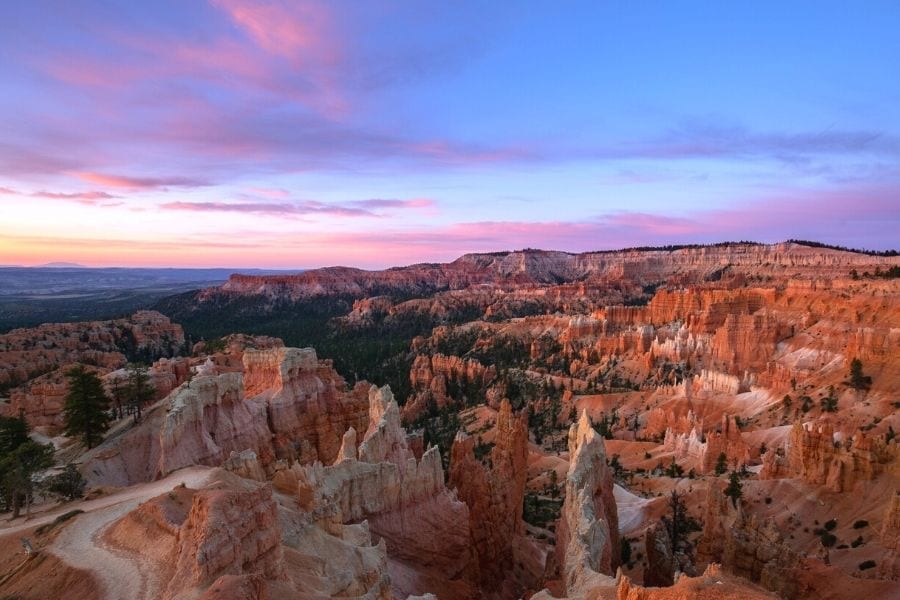
After sunrise, take a hike along the 2.9-mile Queen’s Garden/Navajo Loop Trail to see the hoodoos up close. Start at Sunrise Point and follow the trail clockwise to the endpoint at Sunset Point.
Don’t miss the park’s famous rock formations, like Queen Victoria, Thor’s Hammer, or Wall Street, on this hike.
Read More: 12 Best Bryce Canyon National Park Hikes
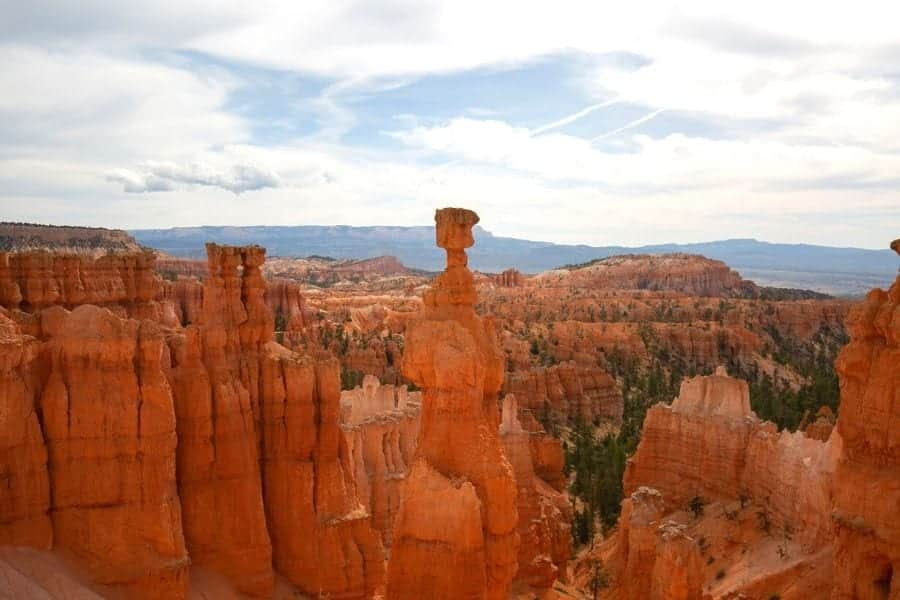
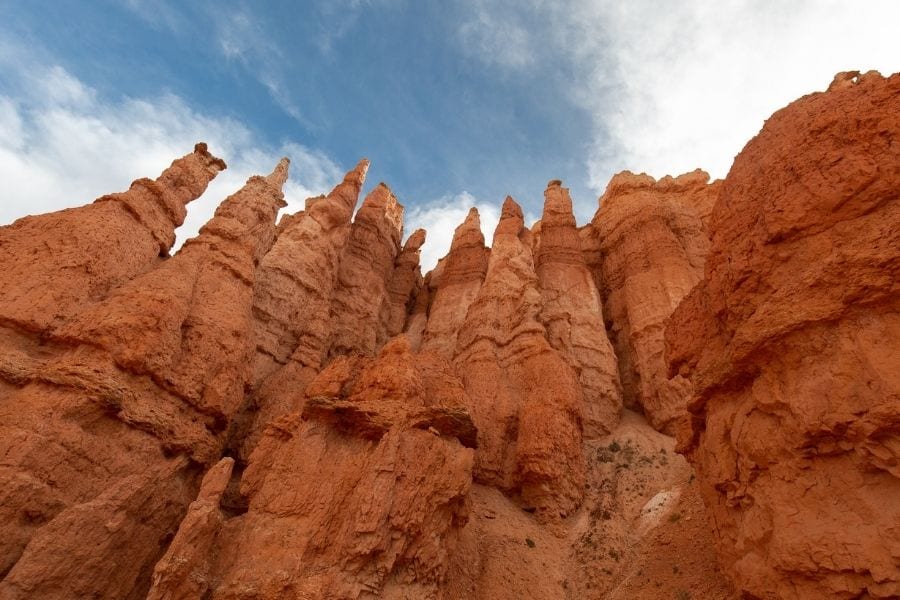
After the hike, take a scenic drive to see the rest of the park. Bryce Canyon has one main road through the park, starting at the visitor center and ending at Rainbow Point.
The 36-mile round trip drive takes about 3 hours with stops and gains over 1,200 feet in elevation.
Start at the visitor center and drive straight to Rainbow Point. After taking in the view at the highest point in the park, make your way back down the drive, stopping at each of the 15 scenic vantage points.
My favorites of the 15 vantage points are Rainbow Point and Bryce Point.

After exploring the highlights of Bryce Canyon, it’s time to head to Capitol Reef National Park. The drive along Highway 12 from Bryce Canyon to Capitol Reef is one of my favorites.
As you drive, the landscape changes from the brushy brown growth near Escalante to tree-filled woods near Capitol Reef.
Some of my favorite vista points along the drive are:
- Powell Point Overlook
- Boynton Overlook
- Calf Creek Viewpoint
- Larb Hollow Overlook
Where to Stay Near Bryce Canyon National Park
While not as big as Springdale, the nearby towns of Bryce and Tropic provide some options for accommodations outside the park.
To get a spot just outside the park, be sure to book 3 to 6 months out.
Bryce Canyon’s in-park accommodations are a hot commodity, especially the lodge. Be sure to book as far out in advance as possible (more than 1 year to stay in the lodge).
This interactive map can also help you search all the available hotels and rental properties near Bryce Canyon National Park! Simply scroll and click the map below to see what is available!
Staying Inside the Park:
- The Lodge at Bryce Canyon, the only hotel inside the park and the most convenient place to stay
- North Campground, first-come, first-served campground open all year
- Sunset Campground, reservable 6 months out from May to October
Staying Outside the Park:
- Best Western Plus Bryce Canyon Grand Hotel or Best Western Plus Ruby’s Inn, the two Best Western locations just outside the park in Bryce
- Bryce Canyon Inn, a budget motel in Tropic, about 15 minutes from the park
- Ruby Inn’s RV Park and Campground, a budget option for camping or glamping outside the park in Bryce
What to Eat Near Bryce Canyon
- Bryce Canyon Pines Restaurant
- Stone Hearth Grille
- The Lodge at Bryce Canyon Dining Room
- Escalante Outfitters (a good pit stop on the way to Capitol Reef)
If You Have More Time in Bryce Canyon
- Hike the Fairyland Loop Trail, a less crowded, more strenuous trail
- Hike the Peekaboo Loop Trail, a longer but incredibly scenic trail in the Bryce Amphitheater
Read More About Bryce Canyon:
Day 5 & 6: Capitol Reef National Park
Drive Time: 2.5 hours from Bryce Canyon National Park
Crowd Levels: 2 out of 5
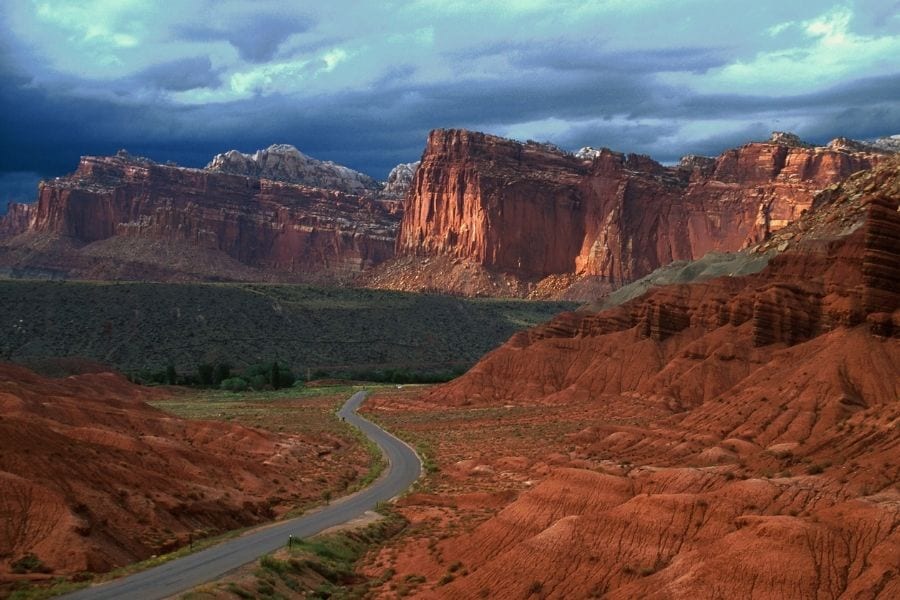
Capitol Reef is the least popular of Utah’s “Mighty 5” national parks. But I think it’s one of the most unique, with a mix of historic landmarks and stunning landscapes.
Capitol Reef National Park surrounds a geological landmark called the Waterpocket Fold. The Waterpocket Fold was some of the last lands in the contiguous 48 states to be charted by cartographers.
Capitol Reef was also home to early Mormon Settlers who built a town in the Fruita District. Here you’ll find a schoolhouse, historic buildings, and a functioning orchard!
Can’t Miss Activities in Capitol Reef National Park
- See Goosenecks Overlook
- Explore Fruita Orchards during Spring bloom or Fall harvest
- Drive the scenic Fruita District
- Hike Capitol Gorge
- Drive to Temple of the Sun and Moon
- Sunset at Panorama Point
Day 5
Start your day in Capitol Reef with a drive out to Goosenecks Overlook. The viewpoint provides expansive views of the valley and creek that carved it.
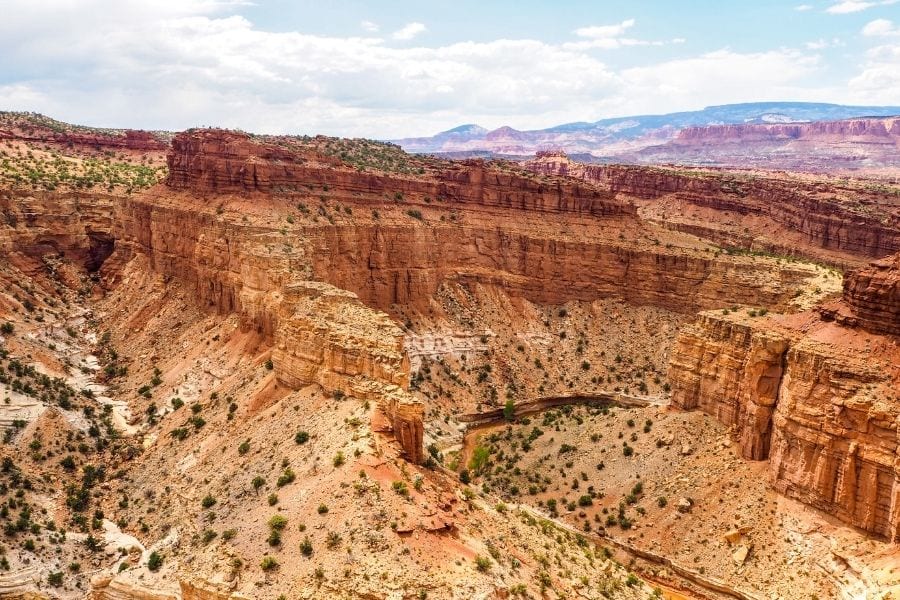
After exploring the overlook, head over to the Fruita District, particularly beautiful in spring or fall. Fruita Orchard blooms in March and April.
In late summer and fall, you can harvest your own cherries, apricots, peaches, pears, and apples.

The rest of the Fruita District of the park is tourable via the park’s main scenic drive. Follow this 8-mile road through the start of the Waterpocket Fold, the park’s famous geological feature.
After reaching the end of the paved scenic drive, take the last stretch of unpaved road to the Capitol Gorge Trail.
This hike takes you along the historic pathway that settlers used to pass through the Waterpocket Fold from the late 1800s to early 1900s

The Temple of the Sun and Moon is the hallmark of the Cathedral Valley district. These pointed rocks shoot out of the desert ground, standing isolated.
To reach the Temple of the Sun and Moon, you’ll have to take a remote dirt road 17 miles away from civilization. An all-wheel-drive vehicle is required for this road as it’s bumpy and rugged.
After exploring the Temple of the Sun and Moon, head back the way you came.
Read More: 15 Best Things to Do in Capitol Reef National Park
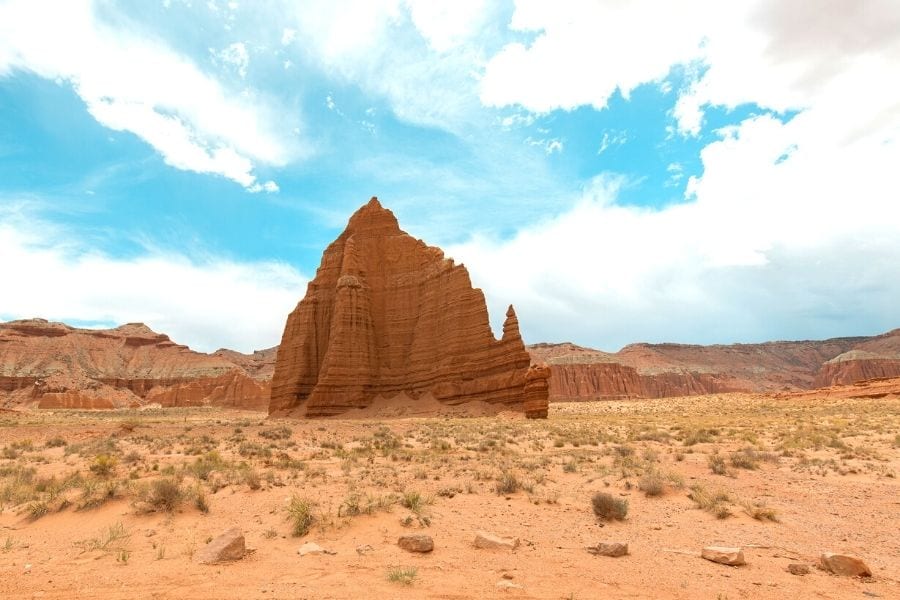
The best spot in Capitol Reef to see the sunset is at Panorama Point. The fading light illuminates the red, striped rocks before fading to darkness, allowing for stellar night sky viewing.
Day 6
More than halfway through your Utah national parks road trip, Day 7 is a day to sleep in, take it slow, and recover. You’ll appreciate having an easy day after back-to-back days of hiking.
Leave Capitol Reef National Park and head to Moab, your home base for visiting both Arches and Canyonlands National Park. The drive to Moab is 2.5 hours through Utah’s arid desert terrain.
This area is remote, so fill up on gas in Torrey or Hanksville.
You can break up your drive along Highway 24 with a stop in Goblin Valley State Park. The hoodoos in Goblin Valley are short and mushroom-shaped, giving them the nickname of “goblins”.
Explore the goblins on the easy 1-mile loop hike from Goblin Overlook. This hike is unshaded and hot, so bring plenty of sunscreen and water.
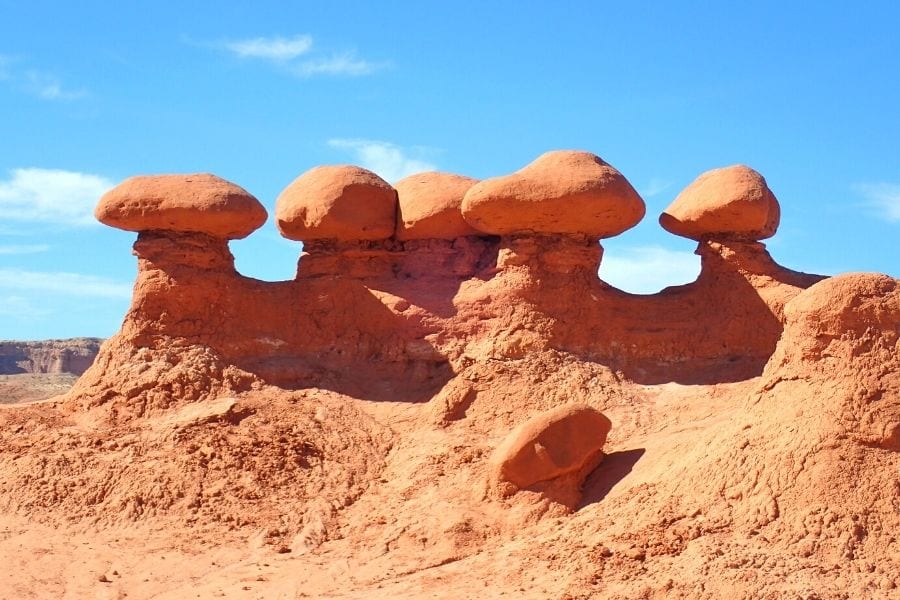
After getting settled into your stay near Moab, catch the sunset at Corona Arch, an enormous arch outside the parks.
This arch is about 20 minutes from Moab, along the Colorado River. Make the 1-mile hike out to the arch and settle in for a glowing sunset.
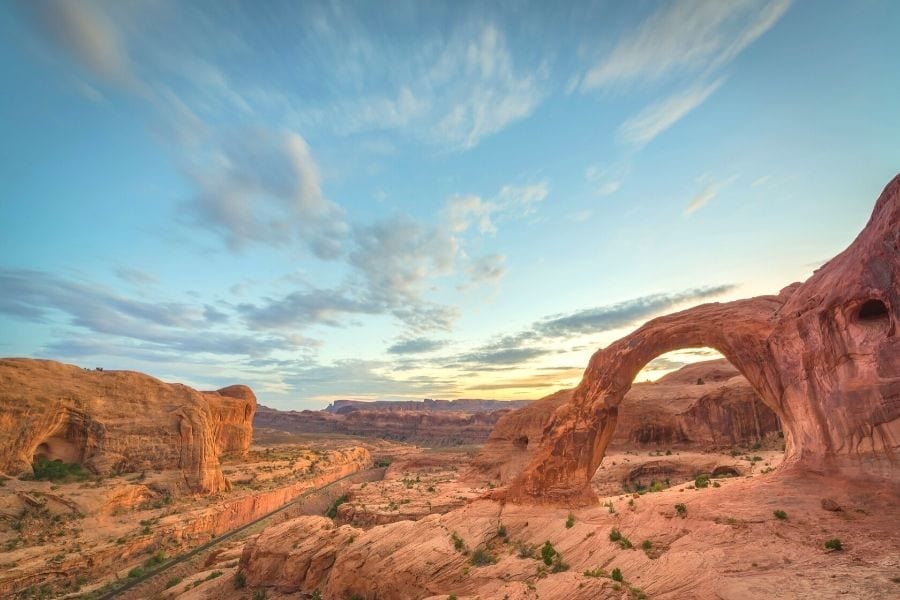
Where to Stay Near Capitol Reef National Park
Since you’ll be spending your time in the Fruita and Cathedral Valley districts in Capitol Reef, you’ll want to stay in this area of the park. The best selection of hotels is found in the nearby town of Torrey.
The only in-park option near the Fruita District is Fruita Campground. This site is first-come, first-served with all the basic necessities.
This interactive map can also help you search all the available hotels and rental properties near Capitol Reef National Park! Simply scroll and click the map below to see what is available!
Staying Inside the Park:
- Fruita Campground, first-come first-served in-park campground
Staying Outside the Park:
- Austin’s Chuckwagon Lodge, for budget travelers in Torrey
- Capitol Reef Resort, for a more luxurious stay in Torrey
What to Eat Near Capitol Reef
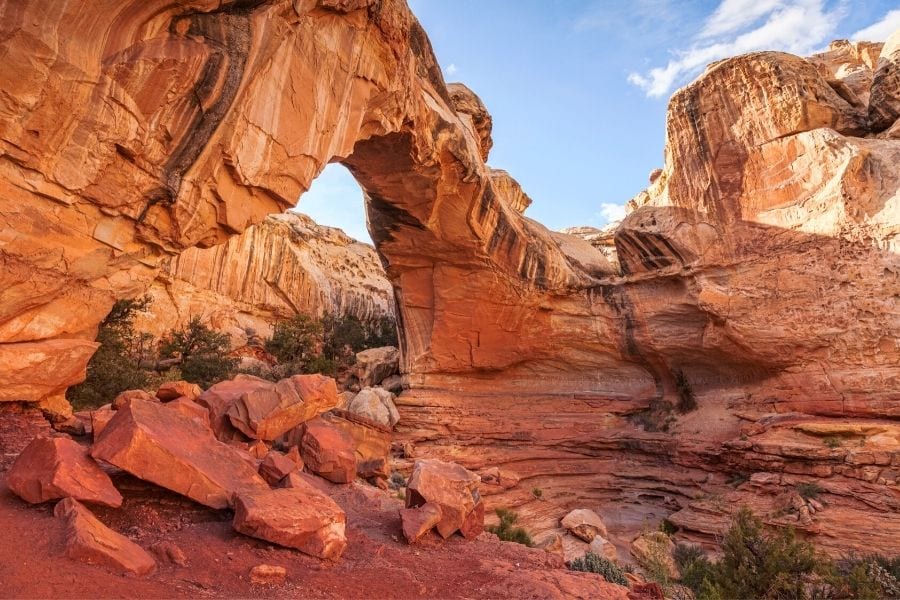
If You Have More Time in Capitol Reef National Park
- Spend the night at Cathedral Valley Campground to explore Temple of the Sun and Moon at sunrise
- Hike the Hickman Bridge Trail, a moderate hike to a natural arch in Capitol Reef
Read More About Capitol Reef:
Day 7 & 8: Arches National Park & Canyonlands National Park
Drive Time: 2.5 hours from Capitol Reef National Park
Arches Crowd Levels: 4 out of 5
Canyonlands Crowd Levels: 3 out of 5
Important Note
In 2024, Arches National Park will require all visitors to get a timed entry permit to enter the park from April to October. You can read more about how to get your Arches entry reservation here. At this point, the four Utah national parks are not requiring a reservation to enter the park.

Arches National Park and Canyonlands National Park are neighbors, only about 1 hour away from each other. Moab, one of the largest towns in southern Utah, is the perfect home base to visit both of these parks in two days.
In Arches National Park, you’ll find more than 2,000 arches formed from the area’s signature red rock. Unlike other parks, many of the main attractions can be reached just off the main park road making this park a great one for families.
Canyonlands National Park is located 45 minutes south of Moab and is the biggest of Utah’s national parks. The most accessible region of Canyonlands is the Island in the Sky District.
This area is reminiscent of the Grand Canyon and home to the famous Mesa Arch.
Can’t Miss Activities in Arches National Park
- Take the Fiery Furnace Ranger-Led Tour
- Drive the scenic drive through the park to the arches
- Hike the Windows loop
- See sunset at Delicate Arch
Can’t Miss Activities in Canyonlands National Park
- See sunrise at Mesa Arch
- Scenic Drive through Island in the Sky District
- Short hike on the Grand View Point Trail
Day 7
With only one day in Arches National Park, you’ll want to make the most of it by starting the daily early to beat the crowds.
I’m not usually a fan of ranger-led tours, but this tour of Fiery Furnace is the exception to the rule. A ranger-led tour is the only way to access Fiery Furnace without a special permit.
Tickets for the morning ranger-led hikes are reservable via Recreation.Gov from May to September. Tickets for this hike are in high demand, so I recommend bookings at least 4-6 months out.
You must check in for the Fiery Furnace Tour at the Arches Visitor Center at least an hour before the hike begins.
Allow plenty of time in the morning to make it to the visitor center by 8 am for the 9 am tour.
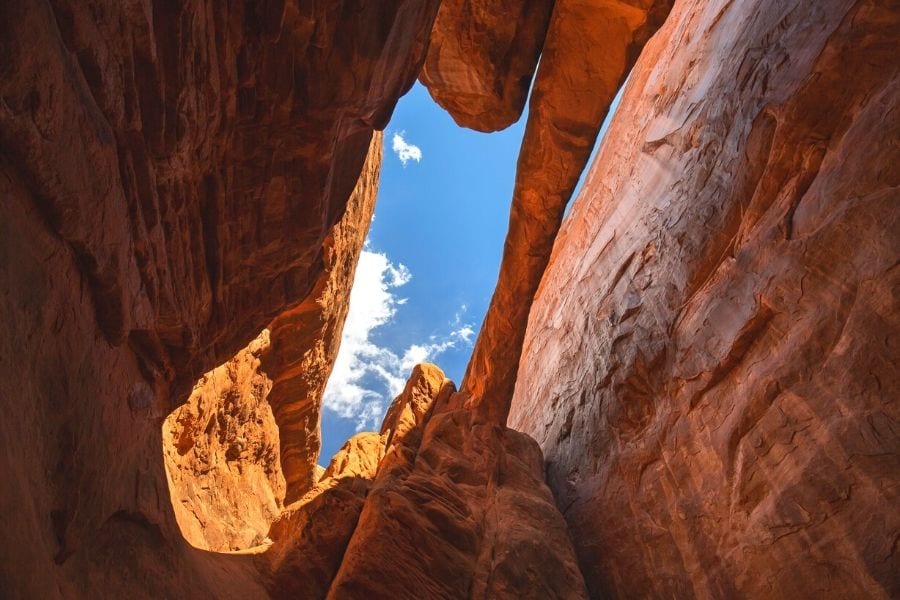
Arches National Park has one main road through the park. This scenic drive takes you past all the best viewpoints in the park, including many arches that you can see from the road.
If you have time after checking in for the Fiery Furnace hike, I recommend stopping at a few points along the scenic drive on your way to the trailhead. Otherwise, retrace your path after you finish the Fiery Furnace hike.
Don’t miss these popular spots along the park’s main road:
- Balanced Rock
- The Windows Section – Double Arch, North Window, South Window, and Turret Arch
- Skyline Arch

Delicate Arch is the crown jewel of Arches National Park. This hike is grueling in the hot heat of midday, so I recommend starting this hike about an hour before sunset.
You’ll gain nearly 500 feet of elevation on the completely exposed 1.5-mile slickrock hike out to the arch.
Once you arrive, settle in and wait for sunset. If you’re there on a new moon, you might even be able to stick around to stargaze and see the Milky Way. I always refer to the Clear Dark Sky charts for night sky visibility day-of.
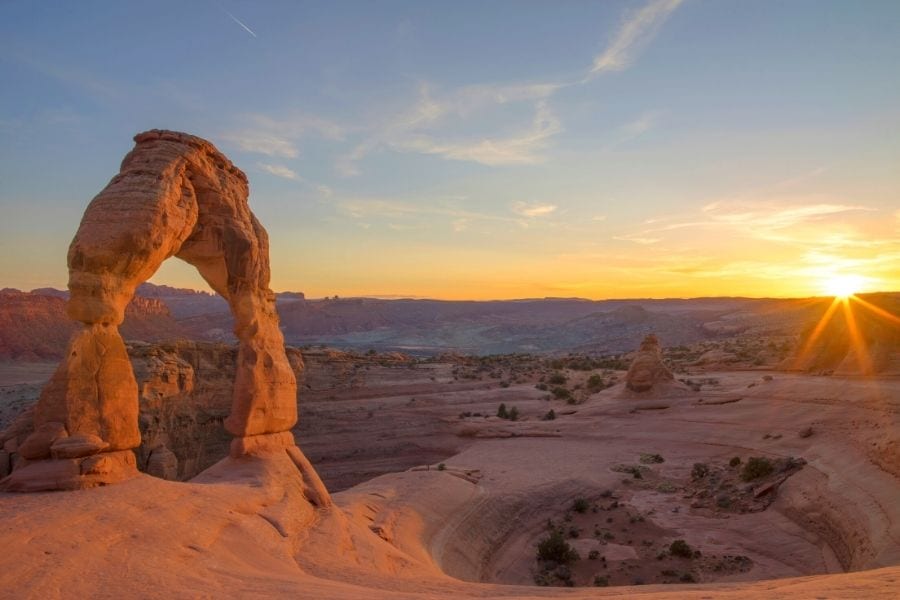
Important Tip for Arches Conservation
While you should take steps to reduce your impact in all national parks, Arches has a particularly fragile environment. The desert ecosystem is easily disturbed by humans straying off the path. Protect the national park by staying on the trail and staying off the arches. Under no circumstances should you ever walk on an arch!
Day 8
With only one day in this park, you’ll want to start your day early. And here, early means before the sun.
Mesa Arch is 45 minutes from Moab. The spectacular sunrise here illuminates the expansive canyon floor in the background and burns bright orange on the underside of the arch.
The trail out to Mesa Arch is an easy 0.5-mile hike, but bring along a headlamp since you’ll be hiking out in the dark.
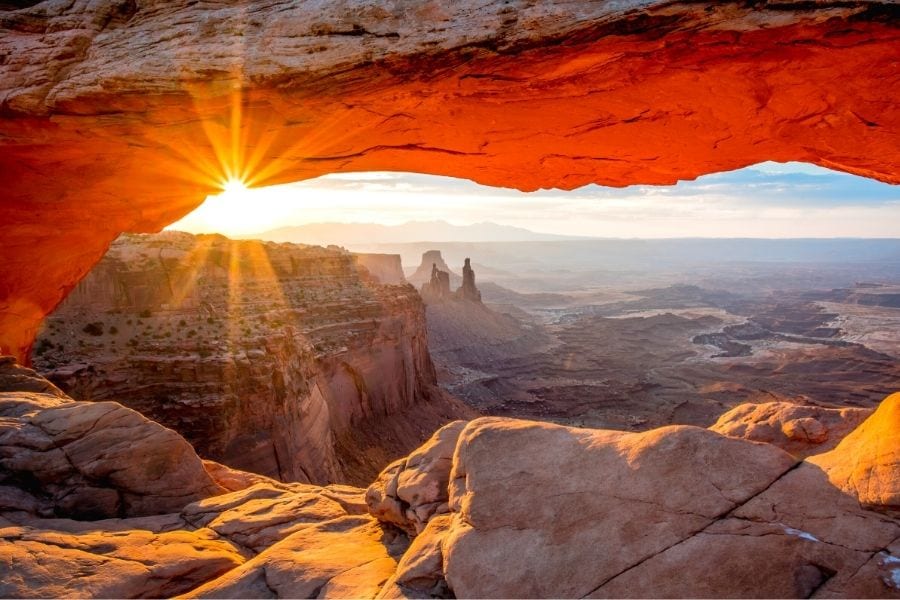
Since you’ll only be in Canyonlands for the day, you’ll only be able to explore the Island in the Sky district.
Other areas of the park, like The Needles and The Maze, are more remote and require a 4×4 vehicle to explore the backcountry.
The best way to see the Island in the Sky district in a short amount of time is via scenic drive.
From Mesa Arch, continue south on Grand View Point Road until you reach Grand View Point. An easy 2-mile trail takes you around the rim of the canyon to the Grand View Point Overlook.
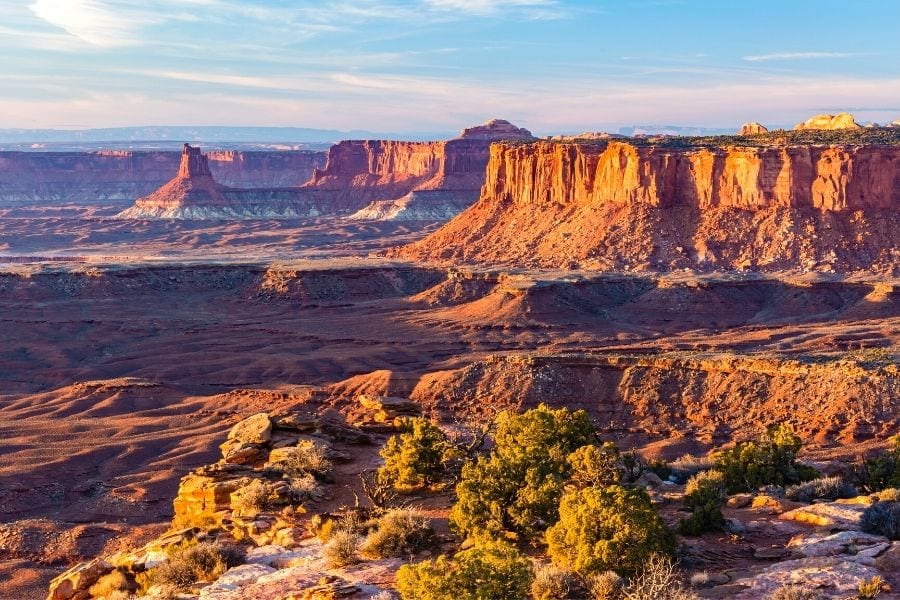
Other spectacular viewpoints include:
- Buck Canyon Overlook
- Green River Overlook
- Shafer Canyon Overlook.

Alas, every good thing must come to an end. After a week exploring southern Utah’s national parks, it’s time to head home.
I recommend booking an evening flight to allow plenty of time to get to the airport or spend one more night in Las Vegas or Salt Lake City.
From Canyonlands, you’re about 4 hours to Salt Lake City and 7 hours to Las Vegas.
Read More: 14 Best National Parks in Southern Utah
Where to Stay Near Arches and Canyonlands
Moab is one of the biggest towns in southern Utah. Here you’ll find a wide array of hotels and Airbnbs. Moab is only 10 minutes outside the Arches National Park entrance and 45 minutes from Canyonlands’ Island in the Sky District.
Plan to book hotels and rentals in Moab at least 3 months out for the best selection.
Neither Arches nor Canyonlands has lodges in the park. The only option to stay in the park is at a campground. To stay in the park, reserve a campground 6 months out.
This interactive map can help you search all the available hotels and rental properties near Arches & Canyonlands National Parks! Simply scroll and click the map below to see what is available!
Staying Inside the Parks:
- Devils Garden Campground in Arches National Park, reservable 6 months out
- Willow Flat Campground in Canyonlands National Park, first-come first-served
Staying Outside the parks:
- Red Cliffs Lodge, a peaceful hotel along the Colorado River in Moab
- Hoodoo Moab, a more luxurious hotel in downtown Moab
- Best Western Plus Canyonlands Inn, a budget-friendly hotel in downtown Moab
- Book an Airbnb for more space and the ability to cook your own meals
Read More: 22 Amazing Places to Stay Near Arches National Park
What to Eat in Moab, Utah
- Sweet Cravings Bakery + Bistro
- Milt’s Stop & Eat
- Quesadilla Mobilla
- 98 Center
- El Charro Loco
- Desert Bistro
- Love Muffin Cafe
- Jailhouse Cafe
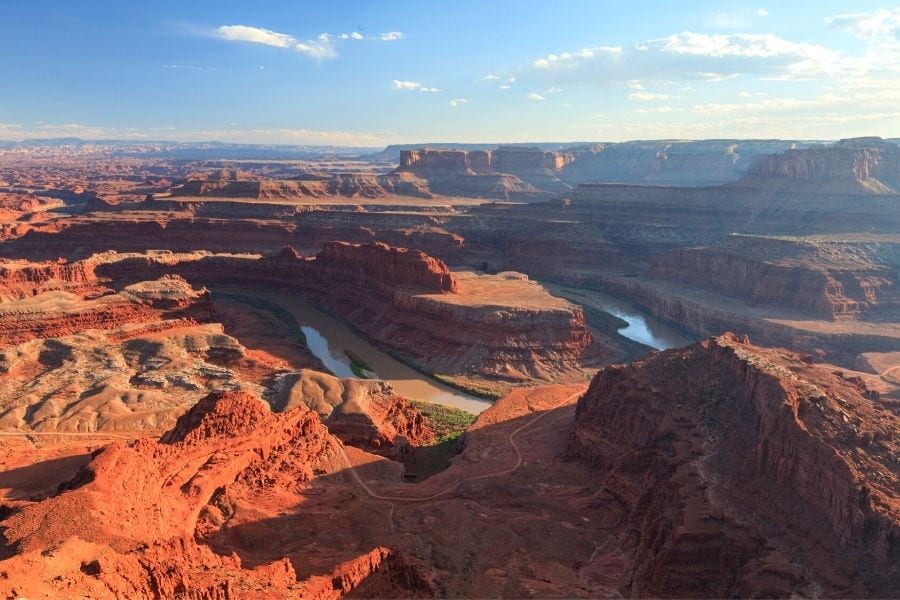
If You Have More Time in Arches or Canyonlands National Park
- Drive White Rim Road in Canyonlands’ Island in the Sky District. This rugged backcountry route takes you along the canyon floor for two days.
- Hike Aztec Butte Trail in Canyonlands, a trail to the historic Puebloan home
- See sunset at Dead Horse Point State Park, just outside of Canyonlands National Park.
- Hike to Landscape Arch and Devil’s Garden in Arches National Park, an easy hike to America’s largest arch
Read More About Arches & Canyonlands:
Extending Your Utah National Parks Road Trip
If you have some extra time to extend your road trip through southern Utah, consider adding these extra stops:
- One Day in Canyonlands National Park exploring The Needles District
- Half Day in Valley of Fire State Park in Nevada hiking to the Fire Wave
- Half Day at Goblin Valley State Park in Utah
- A few hours in Dead Horse Point State Park in Utah
- Half Day at Natural Bridge National Monument in Utah hiking to Sipapu Bridge, Kachina Bridge, and Owachomo Bridge
- One Day in Grand Staircase-Escalante National Monument in Utah hiking Peek-a-boo and Spooky Slot Canyons and Lower Calf Creek Falls
- Half Day in Cedar Breaks National Monument in Utah
- Half Day in Dinosaur National Monument in northern Utah
- One Week exploring Monument Valley, Antelope Canyon, Horseshoe Bend, and Grand Canyon National Park
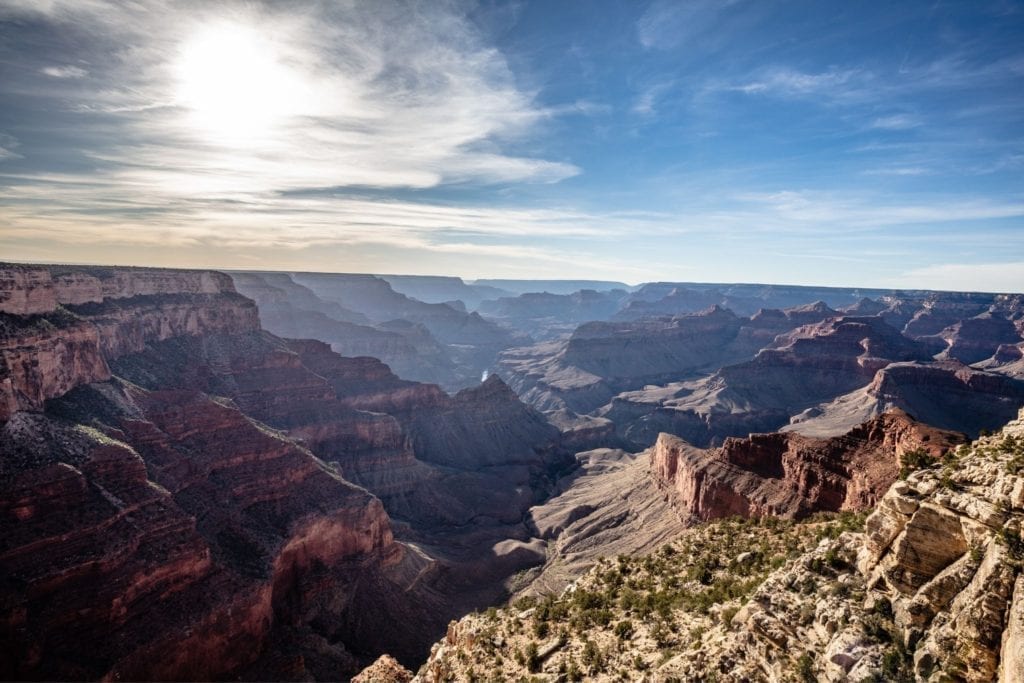
Frequently Asked Questions
How many days do you need for Utah national parks?
To see all 5 of Utah’s national parks, you need 7 to 10 days. This will give you plenty of time to see the highlights of each park at a more leisurely pace.
What is the best time to visit Utah National Parks?
Spring from March to May or Fall from September to November is the best time to visit the Utah national parks. Temperatures are milder and crowds are fewer in these seasons.
Tips for Your Utah National Park Road Trip
- Get the America the Beautiful National Park Pass. This covers your admission to all 5 parks (as well as the rest of the National Park Service) for a full year for only $80. If you don’t go with the national park pass, you’ll need to pay admission at each park totaling $150 (so the pass saves you $70!). Click here to buy your America the Beautiful Pass now.
- Book your trip well in advance if you want to stay in the park. Campsites fill up when reservations are released on a rolling 6-month basis. If you want to stay in a park lodge, plan to book 13 months out when reservations open.
- Start your day early. Utah’s national parks get millions of visitors each year. Start your day shortly after sunrise for the best parking options and avoiding crowds.
- Stock up on groceries before heading to Zion National Park. You’ll save lots of money by grocery shopping before heading to the park, like at the Walmart in St. George.
- Be prepared for thunderstorms. Summer thunderstorms are common in Utah and can be dangerous for hikers. Always check the weather forecast before hiking, particularly for slot canyon hikes like The Narrows in Zion.
- Pack layers. Even in the summer, morning temperatures can be in the 40s and 50s in high elevation parks like Bryce Canyon, so dress in layers to unzip as the day warms up.
- Download maps and trip details offline. Much of this Utah national parks road trip is remote, meaning there’s a high likelihood you’ll be without cell phone service for much of your trip. Download Google Maps for all of southern Utah offline. This will ensure you’re able to navigate even without cell phone service.
- Always carry an emergency kit for hiking and camping. Even on day hikes, you should be carrying the essential gear to survive an emergency night on the trail. Bring a gear repair kit for your camping essentials if you plan to camp on your road trip.
- Keep an emergency roadside kit in your vehicle. At a minimum, this should include a first aid kit, a basic tool kit, blankets, a flashlight, and jumper cables. You should always keep extra water in your car too.
Final Thoughts on 8 Days in Utah’s National Parks
The “Mighty 5” Utah national parks are best visited via a week-long road trip. Plan to visit in April-May or September-October for the best temperatures and to avoid summer crowds. You’ll start your Utah national parks road trip in Las Vegas or Salt Lake City.
For the experience of a lifetime, follow this Utah road trip itinerary:
- Day 1: Drive to Zion National Park
- Day 2: Zion National Park
- Day 3: Zion & Drive to Bryce Canyon
- Day 4: Bryce Canyon & Drive to Capitol Reef
- Day 5: Capitol Reef National Park
- Day 6: Drive to Arches National Park
- Day 7: Arches National Park
- Day 8: Canyonlands National Park & Return Home
Ready to start planning your Utah road trip? Don’t miss this guide on the 14 best national parks in Utah. Plus, you’ll love these posts on Utah’s other national parks:
Zion National Park:
- 3 Day Road Trip from Zion to Bryce Canyon
- 10 Day Road Trip from Zion to Grand Canyon
- The Best Time to Visit Zion
- Hiking Observation Point in Zion
- Ultimate Guide to Zion National Park
Bryce Canyon National Park:
Capitol Reef National Park:
Arches National Park:
Canyonlands National Park:
Don’t miss the best of Utah’s national parks on your upcoming trip! This free, printable Utah national park road trip itinerary covers all the best points of interest in all 5 Utah parks, plus bonus tips on where to stay and side trips to nearby state parks and monuments.
Download your free Utah road trip itinerary here.
Don’t Forget to Save This Post on Pinterest
